Happy Friday!
Today, a book review for a unique instructional book for an equally unique style of embroidery, called “Estense embroidery” – a style hailing from northern Italy, modern in its concept but with roots in the 14th through 16th centuries.
If you’ve been hanging around on Needle ‘n Thread for a while, you might remember that I reviewed Elisabetta Holzer’s first book, Ricamo Estense, back in 2010.
After several years of hard work, Elizabetta has produced an extensive manual that catalogs all the stitches and techniques she incorporates into this enchanting style of embroidery.
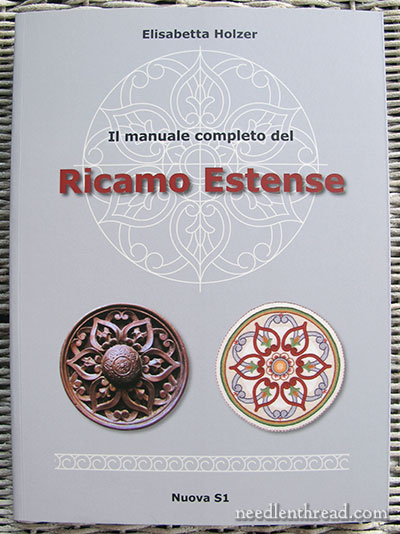
Estense embroidery is essentially an embroidery style conceived by Elizabetta that reflects the artistry found in the painted pottery native to Ferrara, Italy, and the surrounding region. The history of this colorful pottery reaches back as far as the early Renaissance.
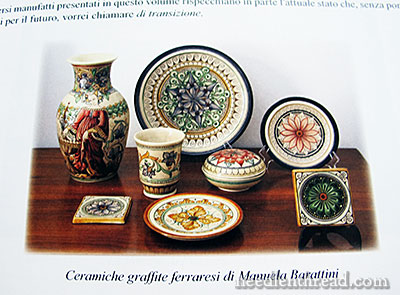
Inspired by the designs and colors of the pottery, but also by the history, architecture, and art of the region, Elizabetta developed a style of embroidery that incorporates both common and uncommon stitches into a coherent whole.
Not only does Estense embroidery reflect the influences mentioned above, but it also incorporates and enlivens old, almost-forgotten techniques found in Italian needlework (particularly in needle laces and the like), presenting them in new, colorful, and modern ways.
The result is an embroidery style that is rather uncommon, somewhat unusual, and immensely appealing.
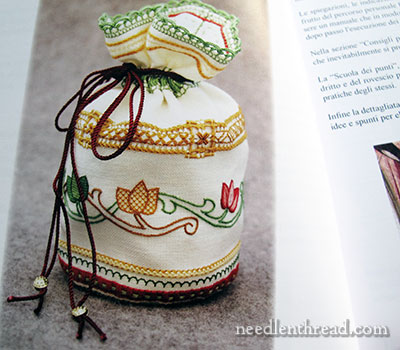
You can see in the example above that the design is a combination of surface embroidery, counted work, needle lace, and even drawn thread work.
The edges of the reticule are embellished with a fine, colorful needlelace. The various lines and bands are worked in combinations of surface embroidery stitches and counted stitches. The central floral band flows across the fabric as only surface stitches can, but the geometric fillings of the flowers typify different types of counted work. Though not completely visible, the neck band of the little bag is drawn together with a hand-made cord that runs through a colorful band of drawn thread work.
So, Estense embroidery embodies quite a range of embroidery types: surface embroidery, counted work, needle lace, and drawn thread work…
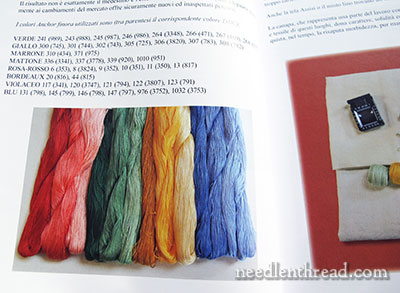
…and it’s all done in color! The colors used in Estense embroidery mirror the colors found in the pottery of the region. Primarily, Elizabetta uses Anchor threads in the work, but she does offer DMC conversions as well.
Now, the book itself. Before we go further, I should let you know that it is entirely in Italian, and unlike the earlier Ricamo Estense, the Complete Manual (which is what I’m reviewing now) will not be available in an English translation.
So, this is a disadvantage, in a sense, if you don’t read Italian. However, the book is so full of clear diagrams and photo instruction that you can learn the techniques and stitches easily without the text.
The only place I find the language barrier problematic is in the projects part of the book, where the instruction is primarily text. Still, a stack of post-it notes and a little time using Google translate, and I was able to piece together the meaning of passages that I wanted to understand.
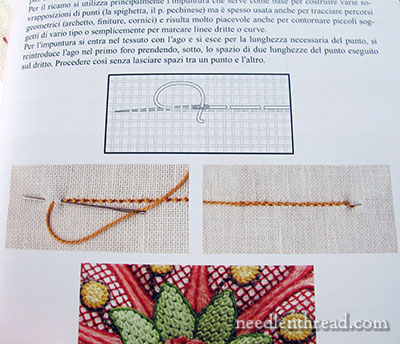
The first part of the book is the instructional manual. Here, you get all the stitch instructions, with photos of the stitch and clear diagrams to show you how to work it.
You’ll find instructions for thirty-six embroidery stitches in the book, progressing from simple to more complex.
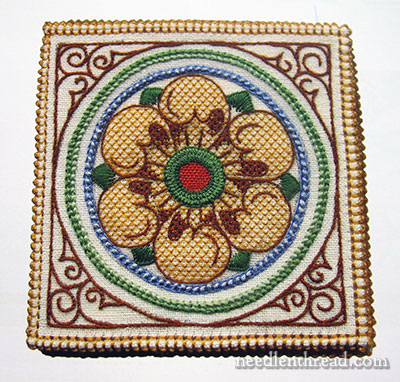
Throughout the instructional part of the book, you’ll find plenty of colorful photos of stitched pieces that show off how all the stitches work together to impart the look specific to Estense embroidery.
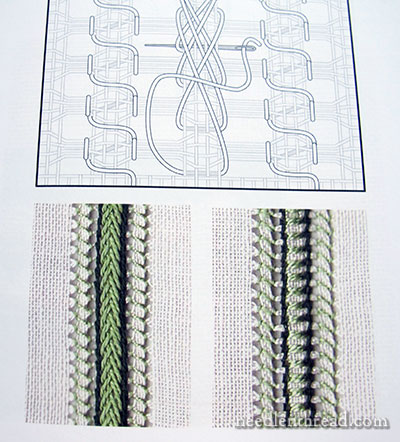
Here’s an example of a stitched band that combines drawn thread work into one lovely decorative band.
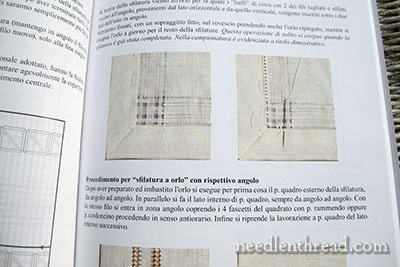
Speaking of drawn thread work, there are clear photos of how to work a variety of beautiful decorative corners in drawn thread. There are eight drawn thread corner treatments detailed in the book.
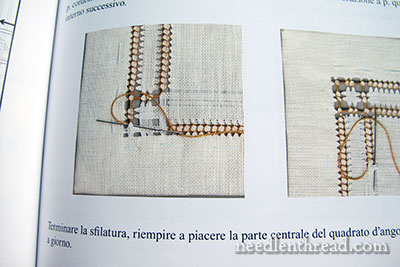
Here’s another place where I employed a post-it note and a translation, just to make sure that I could understand the thread removal information. Often, in drawn thread work, you need to draw a specific number of threads in a specific sequence in order for the corners to work out right. I had no problem with using a computer-generated translation here.
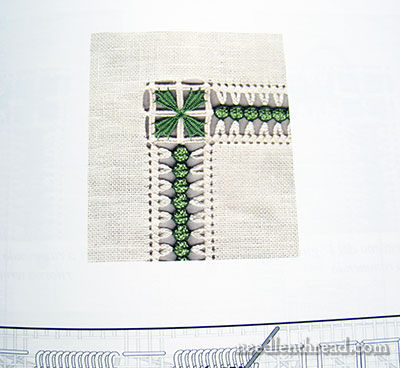
The corners are perfect places to display stitchery and techniques typical of Italian needle lace.
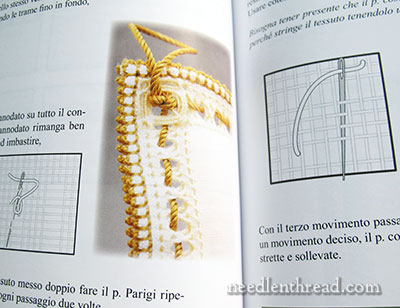
Besides the drawn thread treatments, the manual goes into detail on edge treatments, and what a treat! There are some gorgeous edge treatments in here!
And that brings me to this point: the instruction in the manual is not limited to application in Estense embroidery only.
You know that book cover you want to make? Or that ornament? Or that table runner or tea cloth you embroidered, but you’re not sure how to finish the edge? There are some really nice ideas in here for edge treatments and the like that can be used in all different types of hand embroidery projects.
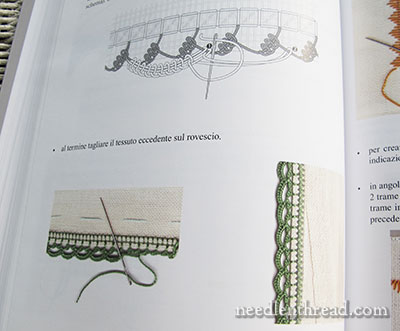
Take, for example, this lovely double scalloped needle lace edge. So pretty!
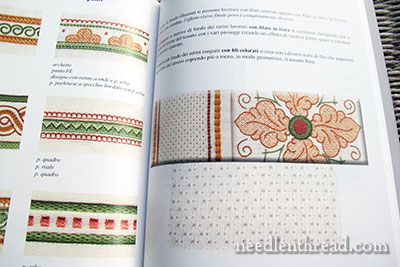
The manual also concentrates on stitching other decorative bands and decorative fillings.
The fillings in Estense embroidery are quite varied. Blackwork techniques, soft shading, needlepoint techniques, Wessex stitchery, Colbert embroidery – all of these techniques and styles seem to meld together and find expression in Estense embroidery.
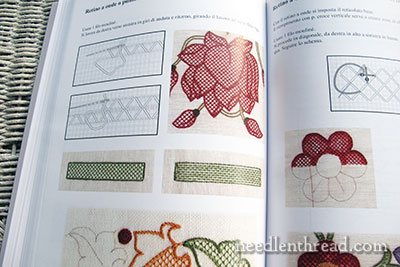
And again, they’re all clearly mapped out with diagrams and photos.
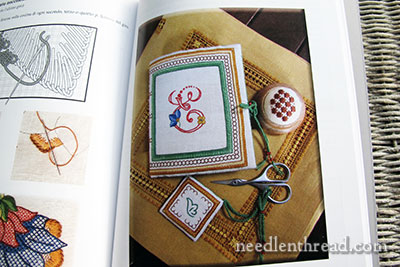
In the last section of the book, you’ll find the projects. There are seven projects, and each is quite beautiful!
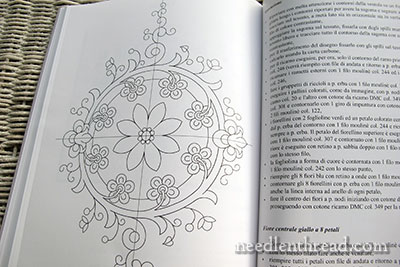
Each project is accompanied by a photo of the finished embroidery, a pattern, a materials list, and instructional text. The instructional text explains the techniques used and the finishing method. The techniques are all those that are explained earlier in the manual. This is where a little translating will come in handy.
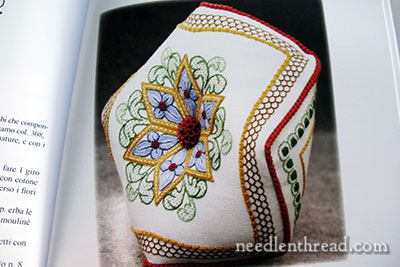
Some of the projects are smaller and simpler, like this biscornu…
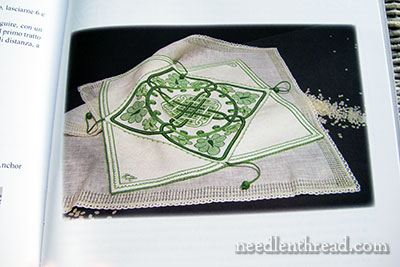
…while some are slightly more complex! For example, this is a gorgeous bomboniere (or wedding favor bag). It combines all the techniques in the book – fillings, bands, drawn thread work, surface stitches, needle lace edges, and hand-made decorative cords.
Where to Find Ricamo Estense
If Italian isn’t in your repertoire, you’ll conveniently find Il Manuale Completo del Ricamo Estense available through The Book Depository, where they offer free world-wide delivery.
It’s also available through Lacis (it’s about $20 more…). Just search their catalog for “Estense”.
You can also find Ricamo Estense through the publisher’s website, Nuova S1, where you can see a flip-through preview of part of the book.
Just a little tip here: if the book appeals to you, now’s the time to get it! Elizabeth’s last book on Estense embroidery is out of print and hard to find. I get inquiries about it all the time from folks who can’t track down any copies of it, but are desperate to find it. So if this style of embroidery appeals to you – if you’re keen to learn these gorgeous decorative bands, fillings, edge treatments, and drawn thread frames and corners, don’t wait on this one. I don’t know how long it will be available!


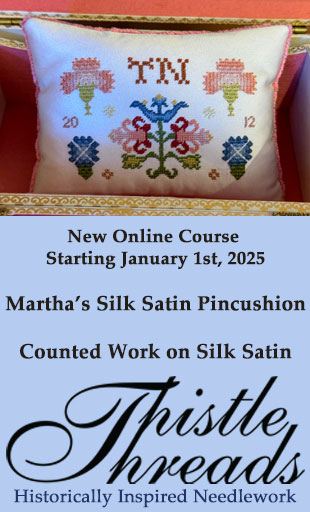
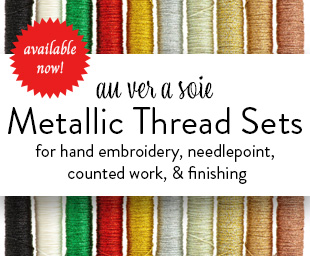
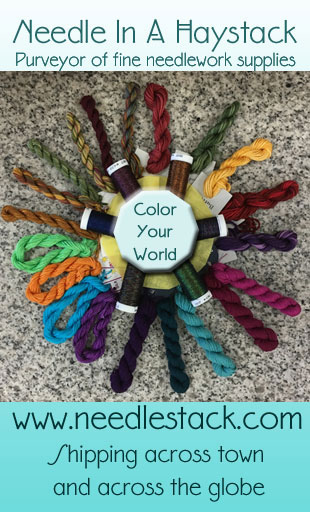
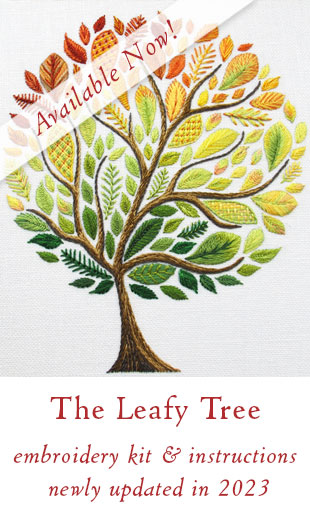

It doesn’t seem like BookDepository has it in stock 🙁
This looks like an awesome book! I love all the project pictures. They’re so vibrant, colourful, and beautiful!
Thanks for reviewing this book, Mrs. Corbet.
Sarah 😀
Postscript: I’m planning on learning to speak Italian someday. Keyword there, ‘someday’.
Oh, do it, Sarah – and do it when you’re young! It’s much easier to learn a language and have it stick with you, the younger you are. If you have the opportunity to study Latin while you’re in school, too, it makes it much easier to pick up the Romance languages. I went through a bout of studying Italian. It was fun! The inflections are so musical. Of course, fifteen years later, the only thing that stuck is …. ciao!
lol! I know it’s easier the younger you are. But I’ve already got my hands full with learning French! Besides French and Italian, I also want to learn Gaelic, Swedish, and German. Goodness, I’d better get busy! 😉
Hi Mary,
Looking for the new book, I looked on this website: http://www.tombolodisegni.it/RICAMO%20ITALIANI.htm
It is tombolo e disegni a lovely shop in Italy, and Gianfranca still has the first book on her website as available. So people searching for it, that is where you can buy it!
That’s great! Thanks a bunch, Lilian!
Wow, that is wonderful! So lovely. Want. It so happens that I am hoping to visit Lacis in real life on Saturday…
I have just checked with Book Depository, and it is no longer available:-( There is a place to enter your email address and they will inform you when it is available again.
I agree with you that Google translator is very helpful when you are getting through this book! I can piece some things together to understand, but a few things don’t translate though. I couldn’t wait to buy this book when I saw it on another site and am so glad I ordered it from the BookDepository when I did (because I know after you review it will be gone!). I am unfortunately, one of the ones that did not do that with her first book and am now looking for it.
Thank you for always keeping us up to date on the best of the embroidery world.
Renetta
I do hope Book Depository gets some more of these books. The more people who sign up for the email the more likely they will source more (I hope).
Thanks for the review Mary. The techniques look wonderful!
It’s a book to drool over. Book Depository didn’t list it so I ordered my copy through Abe Books – who obtained it from Book Depository. It’s now sitting on my shelf ordering me to abandon current WIPs and start stitching from it instead.
What a lovely review Mary! I’m dashing off a quick email to Elisabetta right now, she will be thrilled! 😀
Such wonderful, lively colors! My quest for this book will start tonight!
Too late, she cried. The book is out of stock at Book Depository in USA and UK. Coises, foiled again.
Thanks for the review, though, it looks gorgeous and I can only hope I will get the opportunity to get my hands on a copy some day. Be good to practice my Italian too (my non-existent Italian, that is, lol).
Ciao Mary, grazie mille per la bellissima recensione. Che emozione!
Sono davvero molto felice che il libro sul Ricamo Estense susciti interesse tra le ricamatrici di oltreoceano.
Ho apprezzato molto i commenti!
Auguro a tutte loro di trovare spunti ed idee per futuri lavori divertendosi a “giocare”, con punti, filati e colori. E’ così bello personalizzare e rendere i propri manufatti unici ed originali.
Elisabetta
So… thank you very much for this wonderful review, it’s so lovely! Our books about Italian embroidery usually have a rich section of pictures (and we hope that Google Translate might be of an help for the long written parts!).
As for shipping modalities, we are going to contact Book Depository, in order to see if some books can be made available again through that site. Most of them can be bought on Amazon dot it. but please feel free to contact us directly to make inquiries at: info at nuovas1 dot it as we deliver books around the world.
Thank you again for such a complete and fascinating introduction to our book!
Lorenzo
your work is very interesting to me.i know some stitches, but more and more stitching patterns are learn from you in my small rest time.god bless you for good health.
thank you so much.
Hi, Mary, they have the book on the Amazon Italy site, here http://www.amazon.it/manuale-completo-del-ricamo-estense/dp/888926277X/ref=sr_1_1?s=books&ie=UTF8&qid=1412471564&sr=1-1&keywords=ricamo+estense
It €25.50 there plus shipping. I’ve ordered stuff from the UK and shipping is usually reasonable from Amazon. Looks like a beautiful book.
I want to start one of her borders but am having trouble figuring out what I should use as cotone da ricamo. I generally use DMC so would it be DMC #12? Google translate gave me “instead of cotton embroidery you can use the contone pearl n. 12 can use two wires mouline” from “al posto del cotone da ricamo si puo adoperare il contone perlato n. 12 si possono utilizzare due fili di mouline” (page 18) so I got confused (not the first time, not the last)
Many thanks for suggestions.
Barb
Hi, Barb – Yes, I think she’s talking about #12 perle cotton, or two strands of regular floss. But I think, to keep the look of the finished stitching, the perle cotton would be the better option, because of the twist of the thread.
Cotone da ricamo is cutwork thread, it comes in various weights, you’ll need #25 which comes in colours. Lacis stocks the dmc in the US.
Thanks, Jeanine!!
Hi Mary,
Just received my copy of Ricamo Estense and have loved reading thru’ it. Do you have a sense of what thread count/fabric would be good for these projects? Is Alba Maxima too dense? Is Edinburg at 35 TPI too loose?? Your thought would be appreciated!
Shawne Leach
I’m not Mary Shawne but if you have to order linen anyway for this, what about 38ct Graziano Bellazia? That way you can stick to the 38ct called for. I believe it is on sale right now and it’s even the right colour at Anita’s: http://www.anitalittlestitches.com/bellazia.html
Hope this helps!
I wrote to ask Elisabetta (the author) and she points out that it’s better to go with 35ct rather than 40ct as the #8 pearl cotton is too thick for 40ct. Hope this helps!